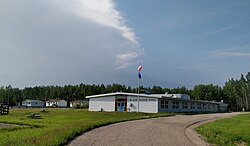Keg River, Alberta
Appearance
Keg River | |
|---|---|
Unincorporated community | |
 Dr. Mary Jackson School | |
Location of Keg River in Alberta | |
| Coordinates: 57°47′18″N 117°51′30″W / 57.7882°N 117.8584°W | |
| Country | Canada |
| Province | Alberta |
| Census division | No. 17 |
| Municipal district | County of Northern Lights |
| Government | |
| • Type | Unincorporated |
| • Governing body | County of Northern Lights Council |
| Elevation | 420 m (1,380 ft) |
| Time zone | UTC-7 (MST) |
Keg River is an unincorporated community in northern Alberta, Canada. It is west of Highway 35 (also known as the Mackenzie Highway) approximately midway between Manning to the south and High Level to the north. It has an elevation of 420 metres (1,380 ft).
The community is located in census division No. 17 and in the federal riding of Peace River. It is administered by the County of Northern Lights.
Climate
[edit]Keg River has a subarctic climate (Köppen climate classification: Dfc). The coldest temperature ever recorded was −51.5 °C (−60.7 °F) on 14 January 2024
| Climate data for Keg River | |||||||||||||
|---|---|---|---|---|---|---|---|---|---|---|---|---|---|
| Month | Jan | Feb | Mar | Apr | May | Jun | Jul | Aug | Sep | Oct | Nov | Dec | Year |
| Record high °C (°F) | 14.5 (58.1) |
16.0 (60.8) |
17.0 (62.6) |
30.0 (86.0) |
33.0 (91.4) |
34.0 (93.2) |
35.0 (95.0) |
32.8 (91.0) |
32.5 (90.5) |
26.5 (79.7) |
16.5 (61.7) |
13.0 (55.4) |
35.0 (95.0) |
| Mean daily maximum °C (°F) | −12.1 (10.2) |
−7.2 (19.0) |
0.3 (32.5) |
9.9 (49.8) |
16.5 (61.7) |
21.4 (70.5) |
22.8 (73.0) |
20.9 (69.6) |
15.7 (60.3) |
7.2 (45.0) |
−5.9 (21.4) |
−9.3 (15.3) |
6.7 (44.1) |
| Daily mean °C (°F) | −18.4 (−1.1) |
−14.3 (6.3) |
−7.3 (18.9) |
2.9 (37.2) |
9.2 (48.6) |
14.1 (57.4) |
16.0 (60.8) |
14.0 (57.2) |
8.8 (47.8) |
1.5 (34.7) |
−11.2 (11.8) |
−15.4 (4.3) |
0.0 (32.0) |
| Mean daily minimum °C (°F) | −24.6 (−12.3) |
−21.4 (−6.5) |
−14.9 (5.2) |
−4.1 (24.6) |
2.0 (35.6) |
6.8 (44.2) |
9.2 (48.6) |
7.0 (44.6) |
2.0 (35.6) |
−4.2 (24.4) |
−16.4 (2.5) |
−21.5 (−6.7) |
−6.7 (19.9) |
| Record low °C (°F) | −51.5 (−60.7) |
−47.0 (−52.6) |
−39.0 (−38.2) |
−31.9 (−25.4) |
−14.0 (6.8) |
−5.0 (23.0) |
−2.4 (27.7) |
−4.5 (23.9) |
−17.2 (1.0) |
−33.5 (−28.3) |
−45.0 (−49.0) |
−46.0 (−50.8) |
−51.5 (−60.7) |
| Average precipitation mm (inches) | 24.7 (0.97) |
19.8 (0.78) |
18.4 (0.72) |
21.2 (0.83) |
36.6 (1.44) |
57.1 (2.25) |
89.0 (3.50) |
63.4 (2.50) |
37.5 (1.48) |
28.5 (1.12) |
30.4 (1.20) |
20.6 (0.81) |
447.2 (17.61) |
| Source: Environment Canada[2] | |||||||||||||
See also
[edit]References
[edit]- ^ "Alberta Private Sewage Systems 2009 Standard of Practice Handbook: Appendix A.3 Alberta Design Data (A.3.A. Alberta Climate Design Data by Town)" (PDF) (PDF). Safety Codes Council. January 2012. pp. 212–215 (PDF pages 226–229). Archived from the original (PDF) on 16 October 2013. Retrieved 8 October 2013.
- ^ "Canadian Climate Normals 1981-2010". Environment Canada. Government of Canada. 20 July 2018. Archived from the original on 17 February 2019. Retrieved 17 February 2019.


